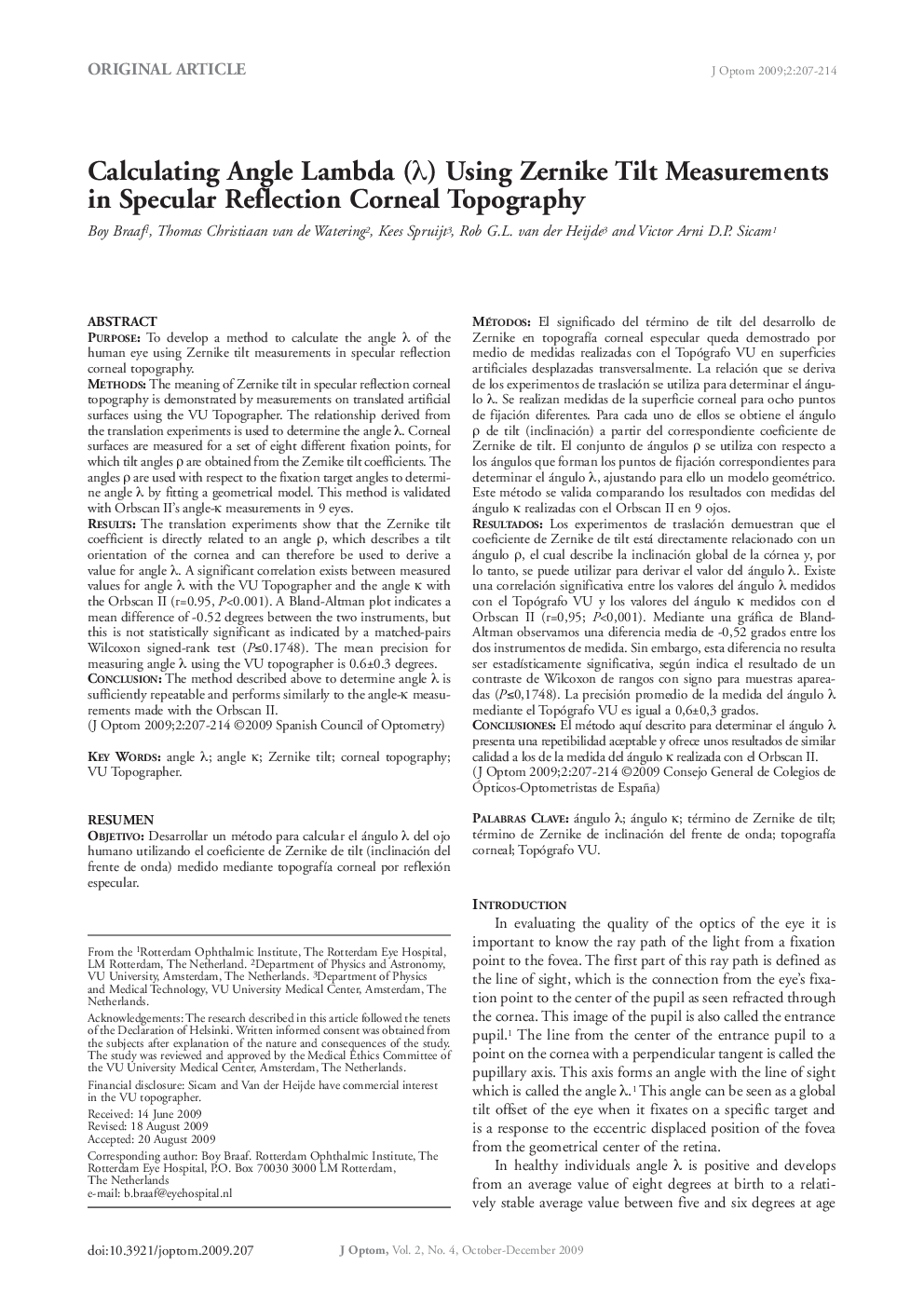| Article ID | Journal | Published Year | Pages | File Type |
|---|---|---|---|---|
| 2698718 | Journal of Optometry | 2009 | 8 Pages |
PurposeTo develop a method to calculate the angle λ of the human eye using Zernike tilt measurements in specular reflection corneal topography.MethodsThe meaning of Zernike tilt in specular reflection corneal topography is demonstrated by measurements on translated artificial surfaces using the VU Topographer. The relationship derived from the translation experiments is used to determine the angle λ. Corneal surfaces are measured for a set of eight different fixation points, for which tilt angles ρ are obtained from the Zernike tilt coefficients. The angles ρ are used with respect to the fixation target angles to determine angle λ by fitting a geometrical model. This method is validated with Orbscan II's angle-κ measurements in 9 eyes.ResultsThe translation experiments show that the Zernike tilt coefficient is directly related to an angle ρ, which describes a tilt orientation of the cornea and can therefore be used to derive a value for angle λ. A significant correlation exists between measured values for angle λ with the VU Topographer and the angle κ with the Orbscan II (r=0.95, P<0.001). A Bland-Altman plot indicates a mean difference of -0.52 degrees between the two instruments, but this is not statistically significant as indicated by a matched-pairs Wilcoxon signed-rank test (P≤0.1748). The mean precision for measuring angle λ using the VU topographer is 0.6±0.3 degrees.ConclusionThe method described above to determine angle λ is sufficiently repeatable and performs similarly to the angle-κ measurements made with the Orbscan II.
ResumenObjetivoDesarrollar un método para calcular el ángulo λ del ojo humano utilizando el coeficiente de Zernike de tilt (inclinación del frente de onda) medido mediante topografía corneal por reflexión especular.MétodosEl significado del término de tilt del desarrollo de Zernike en topografía corneal especular queda demostrado por medio de medidas realizadas con el Topógrafo VU en superficies artificiales desplazadas transversalmente. La relación que se deriva de los experimentos de traslación se utiliza para determinar el ángulo λ. Se realizan medidas de la superficie corneal para ocho puntos de fijación diferentes. Para cada uno de ellos se obtiene el ángulo ρ de tilt (inclinación) a partir del correspondiente coeficiente de Zernike de tilt. El conjunto de ángulos ρ se utiliza con respecto a los ángulos que forman los puntos de fijación correspondientes para determinar el ángulo λ, ajustando para ello un modelo geométrico. Este método se valida comparando los resultados con medidas del ángulo κ realizadas con el Orbscan II en 9 ojos.ResultadosLos experimentos de traslación demuestran que el coeficiente de Zernike de tilt está directamente relacionado con un ángulo ρ, el cual describe la inclinación global de la córnea y, por lo tanto, se puede utilizar para derivar el valor del ángulo λ. Existe una correlación significativa entre los valores del ángulo λ medidos con el Topógrafo VU y los valores del ángulo κ medidos con el Orbscan II (r=0,95; P<0,001). Mediante una gráfica de Bland-Altman observamos una diferencia media de -0,52 grados entre los dos instrumentos de medida. Sin embargo, esta diferencia no resulta ser estadísticamente significativa, según indica el resultado de un contraste de Wilcoxon de rangos con signo para muestras apareadas (P≤0,1748). La precisión promedio de la medida del ángulo λ mediante el Topógrafo VU es igual a 0,6±0,3 grados.ConclusionesEl método aquí descrito para determinar el ángulo λ presenta una repetibilidad aceptable y ofrece unos resultados de similar calidad a los de la medida del ángulo κ realizada con el Orbscan II.
